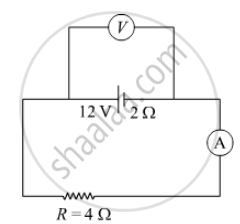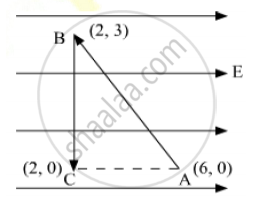Advertisements
Advertisements
प्रश्न
Is there any restriction on the upper limit of the high voltage set up in Van de Graff generator machine? Explain.
उत्तर
The main limiting factor on the value of high potential is the radii of sphere.
If the electric field just outside the sphere is sufficient for dielectric breakdown of air, no more charge can be transferred to it.
For a conducting sphere,
Electric field just outside sphere
`E = Q/(4pi in_0R^2)`
and electric potential
`V = Q/(4piin_0R)`
Thus, E = VR
Now, for E = 3 × 106 V/m (dielectric breakdown)
Radius of should be 1 m.
Thus, the maximum potential of a sphere of radius 1 m would be 3 × 106V.
APPEARS IN
संबंधित प्रश्न
The potential difference applied across a given resistor is altered so that the heat produced per second increases by a factor of 9. By what factor does the applied potential difference change?
In the figure shown, an ammeter A and a resistor of 4 Ω are connected to the terminals of the source. The emf of the source is 12 V having an internal resistance of 2 Ω. Calculate the voltmeter and ammeter readings.

A metal rod of square cross-sectional area A having length l has current I flowing through it when a potential difference of V volt is applied across its ends (figure I). Now the rod is cut parallel to its length into two identical pieces and joined as shown in figure II. What potential difference must be maintained across the length of 2l. so that the current in the rod is still I?

A test charge ‘q’ is moved without acceleration from A to C along the path from A to B and then from B to C in electric field E as shown in the figure. (i) Calculate the potential difference between A and C. (ii) At which point (of the two) is the electric potential more and why?

A capacitor having a capacitance of 100 µF is charged to a potential difference of 50 V. (a) What is the magnitude of the charge on each plate? (b) The charging battery is disconnected and a dielectric of dielectric constant 2⋅5 is inserted. Calculate the new potential difference between the plates. (c) What charge would have produced this potential difference in absence of the dielectric slab. (d) Find the charge induced at a surface of the dielectric slab.
The unit of potential difference as used in electrical circuits is ________.
Two metal pieces having a potential difference of 800 V are 0.02 m apart horizontally. A particle of mass 1.96 × 10–15 kg is suspended in equilibrium between the plates. If e is the elementary charge, then charge on the particle is ______.
On moving a charge of Q coulomb by X cm, W J of work is done, then the potential difference between the points is ______.
A bullet of mass of 2 g is having a charge of 2 µc. Through what potential difference must it be accelerated, starting from rest, to acquire a speed of 10 m/s.
If potential difference between the two ends of a metallic wire is doubled, drift speed of free electrons in the wire ______.
